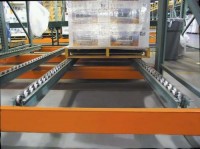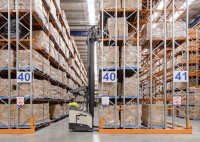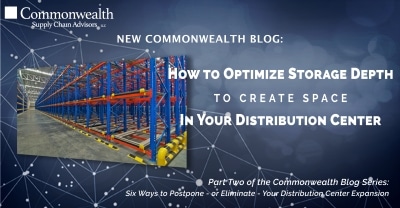This blog is the second in a series I’m writing on ways to optimize space in your distribution center to extend its ability to support growth and postpone a capital expansion project. I covered the concept of slotting as a space-saving strategy in the last post. In this blog, optimizing storage depth is the focus.
One of the largest areas of opportunity for many of companies lies in optimizing storage depth in the distribution center. Warehouses that have a significant number of SKUs where two-to-three pallets are regularly kept on hand should consider storing this product in a medium other than Single-Deep pallet rack. Single-Deep rack sacrifices too much space to aisles to store large quantities of the same SKU in this medium. Instead, companies should consider allocating a certain percentage of their distribution center space, twenty percent for instance, to deep-lane storage mediums such as those listed below:
Push-Back Rack

Push-Back rack can be used to store pallets just two positions deep, or up to five positions, without sacrificing additional space to aisles. Pallets are loaded into the same side of the system from which they are picked. The company’s existing lift trucks can be used to access the rack, and each vertical level of storage can be used to store a different SKU. Drawbacks to Push-Back rack include its cost as well as the fact that FIFO (first-in/first-out) storage is not accommodated. Image Source: Interlake Mecalux
Pallet-Flow Rack

Pallet-Flow rack, on the other hand, does allow FIFO storage. Pallets are fed into the back of the system and retrieved from the front, so more aisle space is required than for Push-Back rack. Storage depths can be much greater than with Push-Back rack (10-deep in some cases), and there is still no special lift truck requirement. Pallet-Flow rack is generally regarded as one of the most expensive ways to store pallets, however. Image Source: Interlake Mecalux
Double-Deep Rack

Double-Deep rack is much less expensive than Push-Back or Pallet-Flow rack, but special “deep-reach” lift trucks are required to access it, which can cost 10% to 20% more than normal reach-style lift trucks. Although pallets can only be stored two positions deep, Double-Deep rack is highly flexible. If designed with this idea in mind, Double-Deep rack can often be reconfigured as Single-Deep rack if requirements change in the future. Image Source: Aceally International
Drive-In Rack

Though relatively inexpensive, Drive-In rack is much more limiting than the three previous storage mediums. Drive-In rack is often configured in depths of four to five pallets, but ALL of the vertical levels in a Drive-In system must contain the same SKU. Companies with frequent occurrences of ten or more pallets of the same product should consider this form of storage. Image Source: Interlake Mecalux
In the next blog in this series, “Narrow Aisles and Very-Narrow Aisles in the Distribution Center: Space Saving Benefits and Equipment Requirements,” we’ll explore aisle widths and the pros on cons associated with the move to narrow (and narrower) aisles. Can’t wait? Read the Whitepaper: Six Ways to Postpone -Or Avoid- DC Expansion or watch the recorded webinar.

